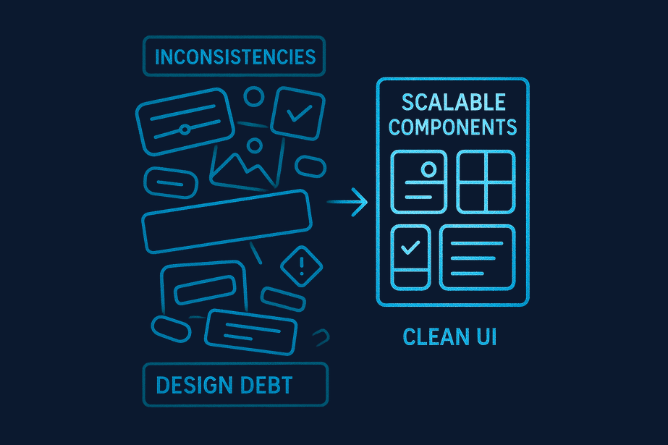No matter how clever your design is, it can’t fix a fundamental flaw: not knowing your users.
Skipping user research is expensive. Remember Snapchat’s 2018 redesign? More than a million users pushed back against the changes, leading to a staggering $1.3 billion drop in market value. That’s the cost of ignoring user insight.
Today, a dedicated user experience researcher is a strategic necessity. In this guide, we’ll break down when to hire one, why they matter, and how they transform your product journey.
What Is a User Experience Researcher?
A user experience researcher bridges the gap between your product’s ambitions and real-world user needs. They systematically study and analyze target users to ensure every design, feature, and product decision is grounded in data and human behavior.
Unlike a UX designer (focused on visual and interactive elements), a user experience ux researcher digs into the “why” and “how” behind user actions using diverse user experience research methods.
A user experience researcher:
- Gathers and analyzes both numerical data (statistics) and non-numerical insights (user behavior and attitudes).
- Uncovers pain points, unmet needs, and new opportunities.
- Provides actionable insights to guide product managers and design teams.
In short, they connect the dots between user behavior and product vision – so you don’t waste time building things nobody wants.

Why Product Teams Can’t Afford to Skip UX Research
Skipping UX research is like building a rocket without knowing where it’s headed and hoping it lands somewhere useful.
In a world where attention spans are short and competition is relentless, guessing your way through product development isn’t just inefficient – it’s dangerous.
Here’s what the data says:
- Forrester reports that businesses can earn up to $100 in return for every $1 they allocate to UX improvements.
- Reports say that UX research cuts development time, reduces rework, and boosts user satisfaction.
- Fixing usability issues in design is 100x cheaper than fixing them after launch.
To make those results measurable, investing in strong user experience analytics helps teams identify exactly what’s working and what’s not through data-backed insights.
Still tempted to skip research?
Whether you’re running lean or scaling fast, partnering with experienced UX research agencies can help you uncover user insights faster and make smarter decisions – without overextending internal teams.
UX research isn’t just about avoiding failure. It’s about giving your product the best possible shot at success from first launch to scale-up.
Top Benefits of Having a User Experience Researcher
Whether you’re launching something new or scaling an existing product, here’s what a user experience researcher can help you unlock—beyond just usability tweaks.
1. De-risks Product Investments
A user experience researcher ensures your features address actual user needs. They use ux research methods – such as interviews, surveys, usability tests, diary studies, and contextual observation – to gather evidence for product decisions. This prevents costly missteps and optimizes resource allocation for product managers.
2. Speeds Up Product-Market Fit
Hiring a user experience researcher early helps teams quickly find product-market fit, validate ideas, and refine features that genuinely resonate with customers. They reveal hidden motivations and decision factors, allowing you to address deep-seated needs.
3. Reduces Design Debt
A dedicated user researcher uncovers usability and conceptual flaws before they become ingrained in your product, minimizing expensive rework.

4. Drives Team Alignment
A user experience researcher translates complex data into clear insights that everyone (from product managers to developers) can rally behind. This fosters better team collaboration and ensures all efforts are tailored to user expectations.
5. Unlocks Innovation
User experience researchers challenge assumptions, discover new behaviors, and spark creative solutions that keep your product ahead of the curve.
In short, a UX researcher doesn’t just enhance your product – they elevate your entire product strategy.
When Should You Hire a User Experience Researcher?
The need for a dedicated UX researcher isn’t tied to company size – it’s tied to the complexity and stakes of the decisions you’re making. If you’re facing any of the scenarios below, it’s likely time to bring one on board.
1. Early in Product Development for User-Centered Design
Hiring a user experience researcher early – ideally during product conceptualization and design – is critical. They help define user needs, clarify pain points, and validate assumptions before costly development begins.
This early-stage research helps product managers and UX teams build a solid foundation based on real users, reducing the risks of building irrelevant or unusable features.
2. When Redesigning or Improving Existing Products
If your product team wants to reimagine an existing product, a user experience researcher can identify usability issues and areas needing enhancement.
Using research methods such as usability testing and A/B testing, they provide empirical evidence of what works and what doesn’t, guiding redesign decisions effectively.

3. To Resolve Unexplained Drops in User Engagement or Conversion
UX researchers can diagnose subtle user experience problems that lead to churn or low conversion. For example, they might find that confusing payment terminology or poor navigation is causing abandonment in a checkout process through user interviews or behavioral analytics. These insights empower precise product improvements.
4. Scaling User Insights Across Multiple Markets or Audiences
When products expand globally or target diverse personas, user experience researchers tailor research to understand varying cultural and behavioral nuances. This avoids one-size-fits-all designs and supports localized, meaningful experiences.

5. Integrating AI for UX Research
The rise of AI-powered research tools offers unprecedented capabilities in analyzing large datasets, identifying behavior patterns, and even simulating user testing scenarios.
Experienced UX researchers who leverage AI for UX research can accelerate insights delivery and uncover deep user trends that traditional methods might miss
If your product is evolving, your understanding of users’ needs has to evolve with it – and that’s where a UX researcher proves invaluable.
Key User Experience Research Methods You Should Know
A world-class user experience researcher is equipped with a toolkit of research methods:
- Quantitative: Surveys, analytics, A/B testing, first-click testing.
- Qualitative: User interviews, diary studies, field studies, contextual observation.
- Discovery: Card sorting, focus groups, usability studies.
Understanding what ux research focuses on is crucial – methods are selected based on your stage, objectives, and resources.
The Evolving Role of AI for UX Research
AI in UX research is rapidly transforming how teams collect, synthesize, and act on user insights. What once took weeks of manual effort—like watching hours of usability sessions or compiling survey feedback – can now be streamlined with intelligent tools.
Today’s AI-powered platforms can:
- Transcribe user sessions in real time: Tools like Dovetail and Hotjar use AI to automatically transcribe, summarize, and timestamp user sessions – freeing researchers from hours of note-taking.
- Cluster feedback into patterns: Sentiment analysis and thematic clustering can quickly categorize open-text responses, helping UX teams identify pain points and trends at scale.
- Generate early UX recommendations: Some tools now go a step further by suggesting design tweaks based on patterns in behavioral data – offering starting points for exploration, not conclusions.
- Run unmoderated tests and analyze results: AI helps run and synthesize remote usability studies faster, by flagging friction areas, auto-tagging user behavior, and mapping it to potential UX issues.
- Translate raw data into dashboards: With natural language querying, platforms like Maze and Useberry allow researchers and PMs to ask questions like, “Where are users dropping off?” and get instant visual answers.
That said, AI is not here to replace UX researchers – it’s here to amplify them. While AI handles repetition and scale, only humans can bring the context, empathy, and strategic thinking required to shape user-centered decisions. No algorithm can truly grasp why a user hesitates on a screen, or how a frustrated experience ties back to an unmet need.
In the near future, the most effective UX research teams won’t be purely AI-driven or purely human – they’ll be hybrid. Researchers who understand how to integrate AI into their workflow will move faster, go deeper, and deliver more value to product teams.
When Your Team May Not Need a Dedicated UX Researcher
Not every team needs a full-time hire immediately. If you’re building a simple MVP, have severe budget constraints, or only need periodic research, it may make sense to:
- Partner with a top user experience research agency to access skills on demand.
- Upskill a designer as a part-time user researcher.
- Use pre-built research templates, AI tools, or external user research panels for smaller projects.
However, as your product and organization mature, dedicated user experience researchers become essential for sustainable growth.
Best Practices for Hiring and Integrating a UX Researcher
Hiring a UX researcher is just the first step – getting real value depends on how well you embed them into your product team and processes. Here’s how to set them up for success from day one.
1. Define Research Goals
Clarify what ux research focuses on for your team: do you need insight into a new demographic, validation of a product concept, or continuous usability improvements?
2. Assess Research Needs
Match the complexity of your product with the proper research scope. Not sure what are ux research methods are most effective for your scenario?
3. Foster Cross-Functional Alignment
Ensure your user researcher, product managers, designers, and developers collaborate from day one. Alignment accelerates research impact.

4. Invest in Tools and Training
Empower your ux researcher with the latest tools in AI for ux research, analytics, and remote user testing. AI platforms now assist with clustering, pattern recognition, and automating repetitive research tasks.
5. Regularly Review Outcomes
Research shouldn’t collect dust -build reporting and knowledge sharing into your product culture. In the long run, the way you integrate your UX researcher will shape not just better user experiences but stronger product outcomes.
Conclusion
Hiring a user experience researcher isn’t just a smart move – it’s a strategic investment in building products people actually want to use. In a market flooded with feature-rich tools and high user expectations, the difference between a product that thrives and one that fails often comes down to this: who truly understands the user.
Whether you’re launching a new product, scaling to new markets, or reworking an existing experience, integrating UX research ensures your decisions are data-backed, user-informed, and future-ready. AI may speed things up, but it’s the human insights from a dedicated UX researcher that drive real product impact.
The best time to hire a UX researcher? Before you realize you should have.
Need expert help embedding research into your product cycle? ProCreator’s UX research specialists are ready to partner with you – wherever you are in your journey.
FAQs
Bring one on during early product development, major redesigns, or when facing drops in engagement or conversion. They’re critical when user insights are needed to guide high-stakes decisions. UX researchers reduce costly mistakes, speed up product-market fit, and uncover unmet user needs. They also improve team alignment and help create more successful, user-friendly products. No – AI tools support and accelerate research, but can’t replace human empathy or strategic thinking. The best results come from UX researchers who use AI to scale their impact.
When should I hire a UX researcher?
What are the benefits of hiring a UX researcher?
Can AI replace UX researchers?






